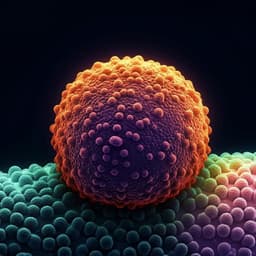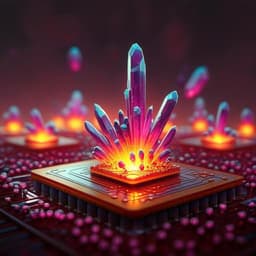Introduction
Colloidal quantum dots (CQDs) are promising materials for optoelectronic applications due to their tunable optical and electrical properties. These properties can be modified through size control and surface chemistry manipulation, leading to advancements in light-emitting diodes, photodetectors, lasers, and photovoltaic devices. Significant progress in CQD solar cell performance has been achieved by increasing the carrier diffusion length (LD), which improves charge extraction efficiency. This is often tackled by minimizing deep electronic trap states at the CQD surface through ligand exchanges, leading to improved carrier transport and longer lifetimes. Another strategy involves creating bulk heterojunctions to separate photoexcited electrons and holes into distinct phases, extending carrier lifetimes and diffusion lengths. This has been demonstrated using CQD/polymer blends or different CQD materials. Bulk homojunctions, using a single CQD material but with differing doping levels, offer advantages in carrier extraction and transport. Ligand functionalization influences the density of states, allowing control over doping levels through the use of different ligands. However, despite the potential benefits, CQD bulk homojunction devices have not surpassed planar devices because of challenges in creating both p-type and n-type CQD inks with complete surface passivation and miscibility. Previous ligand-exchange approaches for p-type CQDs often resulted in surface defects due to steric hindrance from the doping ligands, preventing complete surface coverage, and hindering the creation of homogenous films. This paper introduces a novel cascade surface modification (CSM) strategy to overcome these limitations and achieve homogeneous CQD bulk homojunction solids.
Literature Review
The literature extensively documents the progress in CQD solar cell efficiency through various strategies. Improvements in synthesis techniques, surface passivation methods, and device architectures have all contributed to increased power conversion efficiency (PCE). Studies have shown that increasing the carrier diffusion length is crucial for enhancing performance. Ligand exchange has been a prominent method for surface passivation, leading to longer carrier lifetimes and improved transport. Bulk heterojunction designs, utilizing either CQD/polymer blends or different CQD materials, have also demonstrated enhanced charge separation and collection. The concept of using bulk homojunctions with differently doped CQD materials has been explored, but challenges in achieving both complete surface passivation and the required miscibility of p-type and n-type inks have limited their effectiveness. Prior work highlighted issues with steric hindrance from doping ligands, leading to surface defects and inconsistent film morphology. This research builds upon these previous efforts, addressing the key limitation of achieving homogenous and highly performing bulk homojunction devices.
Methodology
The study employed a novel cascade surface modification (CSM) strategy to synthesize both n-type and p-type CQD inks. This involved a two-step process: initial halogenation of CQD surfaces for improved passivation followed by reprogramming with functional ligands to control doping and solubility. The synthesis began with oleic acid-capped PbS CQDs dispersed in octane. Halogenation was achieved using lead halide anions, transferring the CQDs to DMF for stable colloidal solutions. The second step involved reprogramming the surface with thiol ligands to induce p-type behavior. X-ray photoelectron spectroscopy (XPS) confirmed surface reprogramming. Photoluminescence quantum yield (PLQY) measurements assessed surface passivation, demonstrating a threefold increase in PLQY for CSM-treated CQDs compared to conventional methods, highlighting the importance of the initial halogenation step. A range of functional ligands (TG, ME, CTA, HTP, ATP, MA) were explored, demonstrating the versatility of the CSM approach. Ultraviolet photoelectron spectroscopy (UPS) confirmed the p-type characteristics after surface reprogramming. Kelvin probe force microscopy (KPFM) measured the surface potential difference between n-type and p-type CQDs in the assembled film, revealing a built-in electric field. Space charge-limited current (SCLC) measurements determined the carrier mobilities. For creating bulk homojunction films, the CSM inks needed good miscibility. The researchers investigated the solubility of p-type CQDs in butylamine (BTA), hypothesizing that the functional group in the thiol ligands would determine stability. Experimentation with different ligands (CTA, ME, MPA) confirmed that CTA enabled the formation of stable colloids with BTA. Grazing-incidence small-angle X-ray scattering (GISAXS) confirmed that the films produced using CSM inks exhibited uniform and dense packing of CQDs. Carrier diffusion length was determined using a one-dimensional donor-acceptor scheme. Transient absorption (TA) spectroscopy investigated charge transfer dynamics. Finally, CQD solar cells were fabricated using the CSM bulk homojunction films as the active layer with ITO/ZnO as the electron-accepting layer, a 1,2-ethanedithiol (EDT)-treated layer as the hole-transport layer, and Au as the top electrode. Device performance was characterized via current-voltage (I-V) curves and external quantum efficiency (EQE) measurements. Stability was tested under continuous illumination. Larger-area devices were also fabricated.
Key Findings
The cascade surface modification (CSM) method significantly improved the performance of colloidal quantum dot (CQD) solar cells by creating efficient bulk homojunctions. CSM enabled the synthesis of both n-type and p-type CQD inks with complete surface passivation and excellent miscibility. XPS and PLQY measurements confirmed effective surface reprogramming and passivation by the CSM process, leading to a 3-fold increase in PLQY compared to conventional methods. UPS measurements confirmed the successful creation of n-type and p-type CQDs. The CSM strategy allowed for the use of a wider variety of functional ligands, offering flexibility in tuning CQD properties. KPFM measurements demonstrated a clear surface potential difference between n-type and p-type CQDs in the final film, indicative of a built-in electric field. GISAXS analysis showed that CSM-produced films exhibited significantly improved uniformity and dense packing of CQDs compared to control films. The bulk homojunction films displayed a 1.5-fold increase in carrier diffusion length (340 nm) compared to the previously best-performing CQD films (221 nm), as determined through one-dimensional donor-acceptor measurements. TA spectroscopy revealed ultrafast charge transfer between the n-type and p-type domains in the bulk homojunction film, confirming the type-II heterojunction formation. The CQD solar cells fabricated using the CSM bulk homojunction films achieved a record power conversion efficiency (PCE) of 13.3% (12.47% certified), significantly exceeding the performance of devices based on solely n-type or p-type CQDs. This high PCE stemmed from enhanced short-circuit current density (Jsc) without compromising open-circuit voltage (Voc) or fill factor (FF). The devices showed good stability, maintaining 87% of their initial PCE after 110 hours of operation. Large-area devices (1.1 cm²) also showed comparable performance.
Discussion
The findings demonstrate the remarkable effectiveness of the cascade surface modification (CSM) strategy in overcoming the long-standing limitations associated with creating high-performance CQD bulk homojunction solar cells. The achievement of a 13.3% PCE, representing the highest value reported for CQD photovoltaics, underscores the significant advancement in CQD materials science and device engineering. The enhanced carrier diffusion length, confirmed by both one-dimensional diffusion length measurements and TA spectroscopy, is a direct consequence of the homogenous film formation and the effective separation of charges within the bulk homojunction. The observed ultrafast charge transfer dynamics provide crucial insights into the charge transport mechanisms within the device, supporting the effectiveness of the type-II heterojunction architecture. These results strongly suggest that CSM is a promising approach for overcoming the challenges of achieving high-quality, homogenous CQD solids, paving the way for the development of even more efficient CQD-based optoelectronic devices. The improved miscibility of the n-type and p-type inks is particularly noteworthy, as it directly addresses a key limitation that had previously hindered progress in this area.
Conclusion
This research introduces a groundbreaking cascade surface modification (CSM) technique for fabricating high-performance CQD bulk homojunction solar cells. The CSM strategy successfully addresses the challenges of achieving complete surface passivation and high miscibility of n-type and p-type CQD inks, resulting in a record-breaking power conversion efficiency of 13.3%. This work provides significant advancements in CQD materials science and device engineering. Future research could explore even more diverse functional ligands to further optimize CQD properties, investigate different CQD materials, and explore alternative device architectures to further enhance the efficiency and stability of CQD-based solar cells.
Limitations
While the CSM method demonstrated significant improvements in CQD solar cell performance, certain limitations remain. The study primarily focused on PbS CQDs; the generalizability of the CSM approach to other CQD materials requires further investigation. The fabrication process, involving multiple steps of ligand exchange and film deposition, is relatively complex and may present challenges for large-scale manufacturing. The long-term stability of the devices under various environmental conditions, beyond the 110-hour test, needs further evaluation. Finally, although the larger-area device testing showed comparable Voc and Jsc values, the slightly lower PCE warrants further optimization to reduce the series resistance.
Related Publications
Explore these studies to deepen your understanding of the subject.







